TasunkaWitko
Junior Member
- Joined
- Mar 8, 2016
- Messages
- 99
- Reaction score
- 31
Beet Wine - My First Attempt
No, i'm not crazy ~
My grandfather would make different wines: chokecherry, bullberry, apple, crababbple...and beet. This makes sense, since he was German and Swedish; beets are integral to the foodways of both cultures, not to mention Ukraine, where my German ancestors lived for a few generations before emigrating to North Dakota.
I was out at my parents' place a few nights ago, and talked with my dad about how Grandpa would make this beet wine. Grandpa's "method" (although he probably never would have referred to it that way) consisted of re-purposing a large glass battery case, which would have looked something like this:
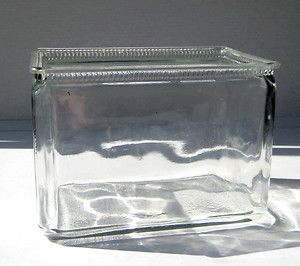
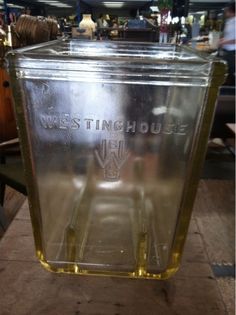
He would wash and peel the beets, then pare them (like a potato), then cut them up into small chunks. He would then toss them into the battery case and add the sugar and water. As to the amounts of beets and sugar, Dad didn't know for sure, but he was certain that Grandpa made wine 5 gallons at a time. Grandpa would then pitch the yeast (bread yeast) and let the magic begin. When it was done working, he'd bottle it, and that was that.
I'm not much of a "real" wine drinker, but I am enjoying these home-made "country" wines more and more, made from the bounty of the land. True connoisseurs might shudder at them, but they taste great, they look wonderful, they are a tie to the land and - for me - have the added bonus of being a connection to my past and a continuation of a family tradition.
I figured to myself, why not? I am a food historian, I'm very keen to explore and preserve my "Germans from Russia" heritage, and it's a tie to one of the greatest men I've known in my life. I should give this a try....I mean really, the more I think about it, what could be more "German-from-Russia" than beet wine?
So - for all of the Doubting Thomases out there, this one's for you!
This is a pretty easy story to tell, so far:
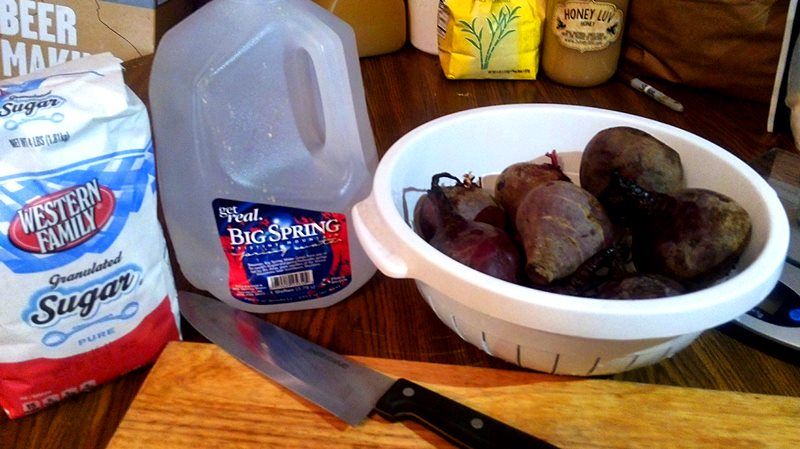
3.4 pounds of beets, sugar and spring water; not pictured are a package of Montrachet wine yeast and a campden tablet (to protect the wine from infection and to ward off oxidation). You can read more about campden tablets and their purpose in winemaking here:
http://www.midwestsupplies.com/purpose-of-campden-tablets
Note: The (very) few recipes that I found for beet wine contain several additives that probably "balance" and "improve" the wine to something a little more in line with modern practices. Pectic enzyme is presumably not necessary; however the biggest benefit that I can see would probably be some acid blend. I do not know for sure if this is the case, but I suspect that it might be. On the other hand, some reports stated that beet wine made the "right" way - that is, with the additives - has been lackluster and even inferior. I will most likely experiment with some of those additives at some point, but for this first attempt, I chose to stick with just the campden tablet, and called it good.
Moving forward, I cut off the tops and roots of the beets, then pared them with a carrot peeler:
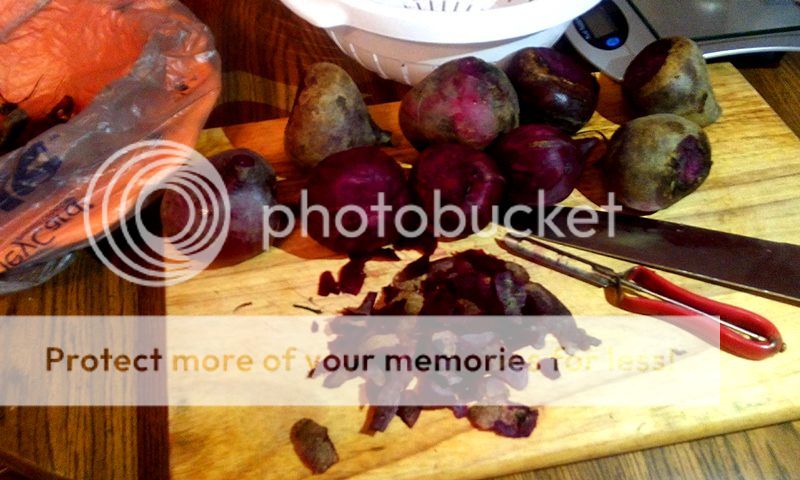
Some recipes said that paring the beets is unnecessary, but my grandfather did this, so I did, too. The peelings, roots and tops of the beets were buried in the garden, to keep the land happy.
This actually left me with exactly 3 pounds of beets:
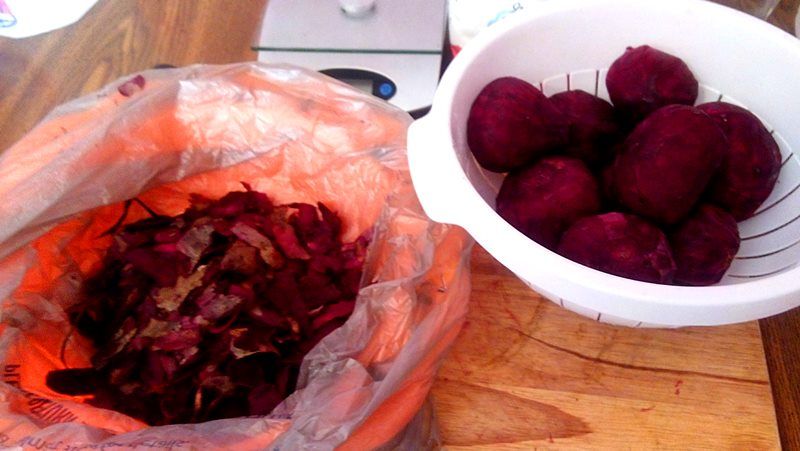
I was estimating that I would have anywhere from 2.5 to 3 pounds total, so this was just fine.
My grandfather would then chop up the beets into small pieces with a knife; however, I am either too lazy or too busy to do that, so I cut them into medium-sized pieces, then pulsed them through my food processor:
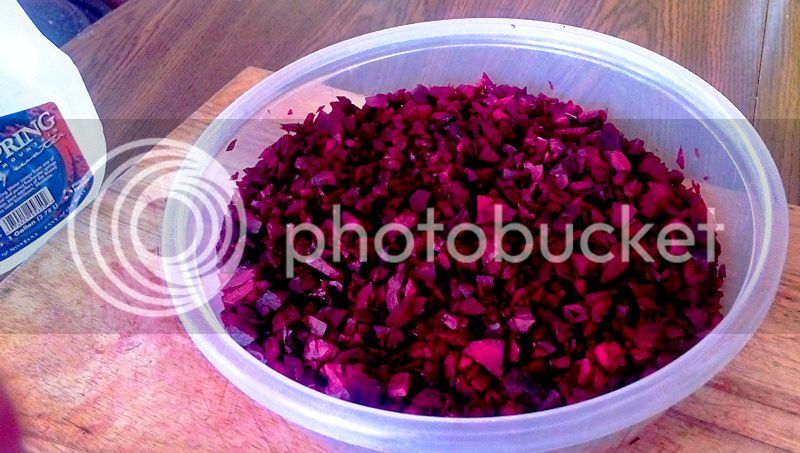
This seemed to work quite well.
Some recipes call for cooking the beets at this point, in order to extract the juice. This seems unnecessary to me, and could, in my opinion, result in some sort of off-flavor. Would it? Won't it? I don't know. But the thing is, my grandfather did not cook the beets; my father insisted on that - so I didn't cook them, either.
Meanwhile, I heated my gallon of spring water on the stovetop to the point where it would easily dissolve 3 pounds of sugar. This amount of sugar was arrived at after reading the recipes referred to above, and should be a good amount.
By this point, I was starting to wonder if I was the recipient of some family joke, but I kept with it anyway, and am glad that I did.
The next step was to put the beets into a fine mesh bag, then pour the warm sugar water on top of the bag in the fermenting bucket, along with a crushed campden tablet. The water turned beet-red (no pun intended) immediately:
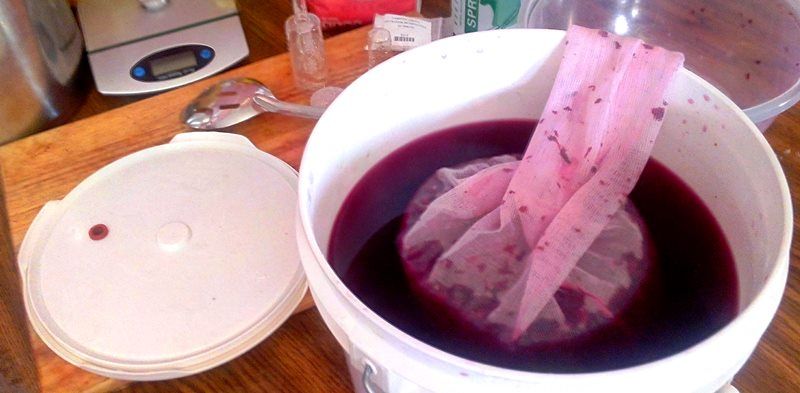
Truly a beautiful colour!
I loosely covered the bucket with a clean tea towel, then set it in a dark, temperature-stable place for 24 hours. After that, I stirred the mixture and pitched the wine yeast.
Since then, I have been stirring the must periodically, and using the large spoon to squish down the bag in order to continue to extract juice from the beets. this project is cruising right along; we're definitely making wine, and that's a good start.
Ambient temperatures have been a bit on the low side, in the mid 60s; I'm not too concerned about this, but it is something that should be noted. I try to keep temperatures around 69-71, but my "temperature control system" consists of a closet lined with clothes and a space heater, so it's not going to be an exact science. No worries, though, as I am pretty sure most farmhouses that made this stuff didn't have a laboratory nearby.
The beet aroma is coming through nicely, without being over-bearing or obnoxious. I have managed to sneak a couple of very small samples clinging to the spoon after stirring the must; early impressions are that I am onto something really good here, and I am thinking that I will end up with some very interesting wine. It's too early to really describe it, but it is definitely good, and for the most part unexpected.
And...the colour is simply beautiful - I can't say enough about that!
We're past the halfway point for primary fermentation; this weekend, I'll most likely transfer the must over to secondary, unless I see a reason not to.
That is all for now - more as it happens, etc. &c....
Ron
No, i'm not crazy ~
My grandfather would make different wines: chokecherry, bullberry, apple, crababbple...and beet. This makes sense, since he was German and Swedish; beets are integral to the foodways of both cultures, not to mention Ukraine, where my German ancestors lived for a few generations before emigrating to North Dakota.
I was out at my parents' place a few nights ago, and talked with my dad about how Grandpa would make this beet wine. Grandpa's "method" (although he probably never would have referred to it that way) consisted of re-purposing a large glass battery case, which would have looked something like this:


He would wash and peel the beets, then pare them (like a potato), then cut them up into small chunks. He would then toss them into the battery case and add the sugar and water. As to the amounts of beets and sugar, Dad didn't know for sure, but he was certain that Grandpa made wine 5 gallons at a time. Grandpa would then pitch the yeast (bread yeast) and let the magic begin. When it was done working, he'd bottle it, and that was that.
I'm not much of a "real" wine drinker, but I am enjoying these home-made "country" wines more and more, made from the bounty of the land. True connoisseurs might shudder at them, but they taste great, they look wonderful, they are a tie to the land and - for me - have the added bonus of being a connection to my past and a continuation of a family tradition.
I figured to myself, why not? I am a food historian, I'm very keen to explore and preserve my "Germans from Russia" heritage, and it's a tie to one of the greatest men I've known in my life. I should give this a try....I mean really, the more I think about it, what could be more "German-from-Russia" than beet wine?
So - for all of the Doubting Thomases out there, this one's for you!
This is a pretty easy story to tell, so far:

3.4 pounds of beets, sugar and spring water; not pictured are a package of Montrachet wine yeast and a campden tablet (to protect the wine from infection and to ward off oxidation). You can read more about campden tablets and their purpose in winemaking here:
http://www.midwestsupplies.com/purpose-of-campden-tablets
Note: The (very) few recipes that I found for beet wine contain several additives that probably "balance" and "improve" the wine to something a little more in line with modern practices. Pectic enzyme is presumably not necessary; however the biggest benefit that I can see would probably be some acid blend. I do not know for sure if this is the case, but I suspect that it might be. On the other hand, some reports stated that beet wine made the "right" way - that is, with the additives - has been lackluster and even inferior. I will most likely experiment with some of those additives at some point, but for this first attempt, I chose to stick with just the campden tablet, and called it good.
Moving forward, I cut off the tops and roots of the beets, then pared them with a carrot peeler:

Some recipes said that paring the beets is unnecessary, but my grandfather did this, so I did, too. The peelings, roots and tops of the beets were buried in the garden, to keep the land happy.
This actually left me with exactly 3 pounds of beets:

I was estimating that I would have anywhere from 2.5 to 3 pounds total, so this was just fine.
My grandfather would then chop up the beets into small pieces with a knife; however, I am either too lazy or too busy to do that, so I cut them into medium-sized pieces, then pulsed them through my food processor:

This seemed to work quite well.
Some recipes call for cooking the beets at this point, in order to extract the juice. This seems unnecessary to me, and could, in my opinion, result in some sort of off-flavor. Would it? Won't it? I don't know. But the thing is, my grandfather did not cook the beets; my father insisted on that - so I didn't cook them, either.
Meanwhile, I heated my gallon of spring water on the stovetop to the point where it would easily dissolve 3 pounds of sugar. This amount of sugar was arrived at after reading the recipes referred to above, and should be a good amount.
By this point, I was starting to wonder if I was the recipient of some family joke, but I kept with it anyway, and am glad that I did.
The next step was to put the beets into a fine mesh bag, then pour the warm sugar water on top of the bag in the fermenting bucket, along with a crushed campden tablet. The water turned beet-red (no pun intended) immediately:

Truly a beautiful colour!
I loosely covered the bucket with a clean tea towel, then set it in a dark, temperature-stable place for 24 hours. After that, I stirred the mixture and pitched the wine yeast.
Since then, I have been stirring the must periodically, and using the large spoon to squish down the bag in order to continue to extract juice from the beets. this project is cruising right along; we're definitely making wine, and that's a good start.
Ambient temperatures have been a bit on the low side, in the mid 60s; I'm not too concerned about this, but it is something that should be noted. I try to keep temperatures around 69-71, but my "temperature control system" consists of a closet lined with clothes and a space heater, so it's not going to be an exact science. No worries, though, as I am pretty sure most farmhouses that made this stuff didn't have a laboratory nearby.
The beet aroma is coming through nicely, without being over-bearing or obnoxious. I have managed to sneak a couple of very small samples clinging to the spoon after stirring the must; early impressions are that I am onto something really good here, and I am thinking that I will end up with some very interesting wine. It's too early to really describe it, but it is definitely good, and for the most part unexpected.
And...the colour is simply beautiful - I can't say enough about that!
We're past the halfway point for primary fermentation; this weekend, I'll most likely transfer the must over to secondary, unless I see a reason not to.
That is all for now - more as it happens, etc. &c....
Ron

























![[Upgraded] 9Pcs Tree Root Growing Box with Drain Holes, Half Transparent Plant Rooting Propagation Ball & Metal Core Twist Ties, for Fast Propagation Plants (Size M)](https://m.media-amazon.com/images/I/514MWQxtWOL._SL500_.jpg)





























